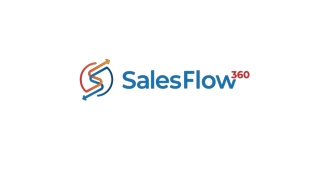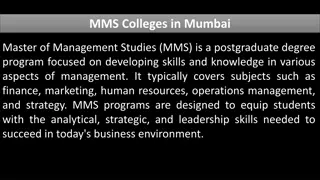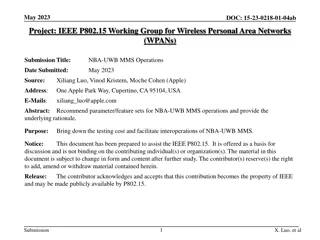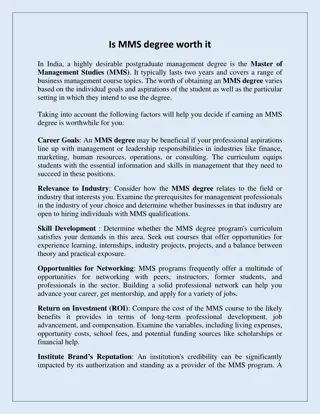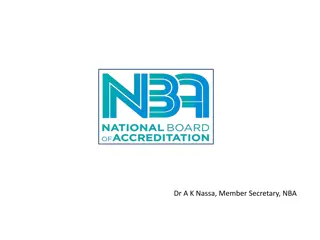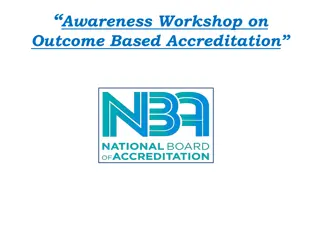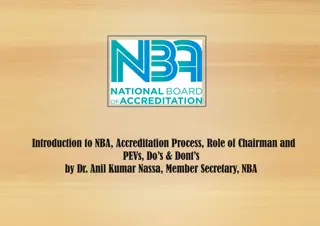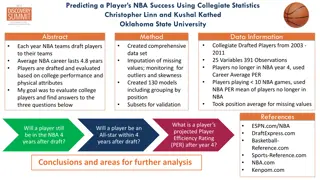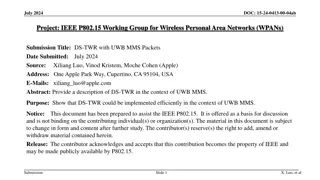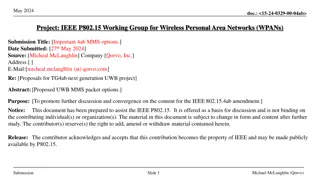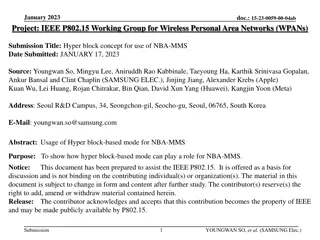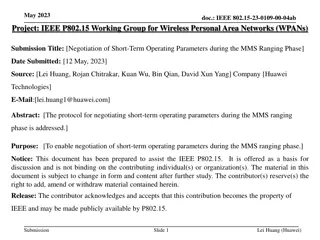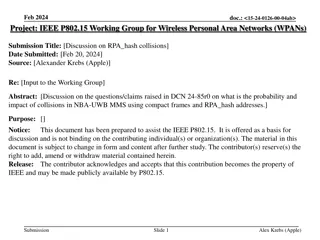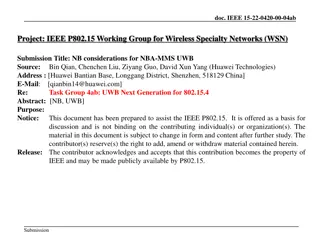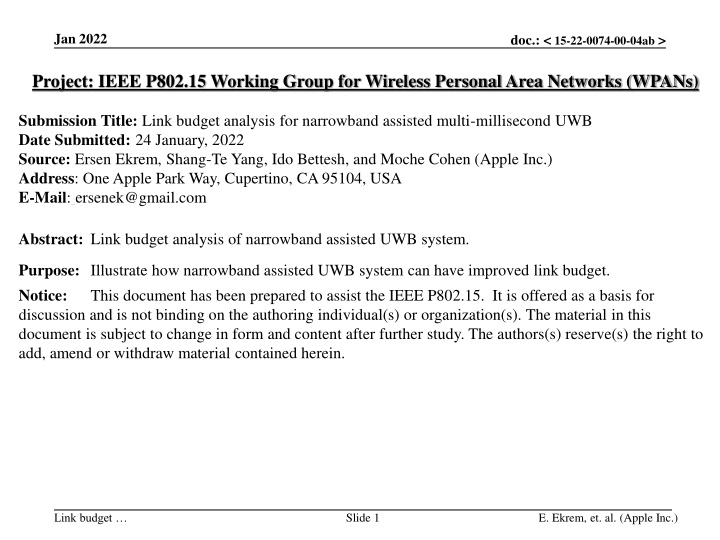
Improved Link Budget Analysis for Narrowband Assisted Multi-Millisecond UWB
Explore the link budget analysis of a narrowband assisted ultra-wideband (UWB) system, showcasing how it enhances link budget and improves performance. The document presents solutions for interference mitigation, backward compatibility, improved accuracy, reduced complexity, and more to support various data use cases. Discover synergistic interactions between narrowband and UWB technologies for enhanced system performance and efficiency.
Download Presentation

Please find below an Image/Link to download the presentation.
The content on the website is provided AS IS for your information and personal use only. It may not be sold, licensed, or shared on other websites without obtaining consent from the author. If you encounter any issues during the download, it is possible that the publisher has removed the file from their server.
You are allowed to download the files provided on this website for personal or commercial use, subject to the condition that they are used lawfully. All files are the property of their respective owners.
The content on the website is provided AS IS for your information and personal use only. It may not be sold, licensed, or shared on other websites without obtaining consent from the author.
E N D
Presentation Transcript
Jan 2022 doc.: < 15-22-0074-00-04ab > Project: IEEE P802.15 Working Group for Wireless Personal Area Networks (WPANs) Submission Title: Link budget analysis for narrowband assisted multi-millisecond UWB Date Submitted: 24 January, 2022 Source: Ersen Ekrem, Shang-Te Yang, Ido Bettesh, and Moche Cohen (Apple Inc.) Address: One Apple Park Way, Cupertino, CA 95104, USA E-Mail: ersenek@gmail.com Abstract: Link budget analysis of narrowband assisted UWB system. Purpose: Illustrate how narrowband assisted UWB system can have improved link budget. Notice: This document has been prepared to assist the IEEE P802.15. It is offered as a basis for discussion and is not binding on the authoring individual(s) or organization(s). The material in this document is subject to change in form and content after further study. The authors(s) reserve(s) the right to add, amend or withdraw material contained herein. Slide 1 E. Ekrem, et. al. (Apple Inc.) Link budget
Jan 2022 doc.: < 15-22-0074-00-04ab > PAR Objective Safeguards so that the high throughput data use cases will not cause significant disruption to low duty-cycle ranging use cases Interference mitigation techniques to support higher density and higher traffic use cases Other coexistence improvement Proposed Solution (how addressed) Backward compatibility with enhanced ranging capable devices (ERDEVs) Improved link budget and/or reduced air-time Use coordinated PHY signaling (NB and UWB) to improve link budget and/or to reduce air-time Additional channels and operating frequencies Improvements to accuracy / precision / reliability and interoperability for high-integrity ranging Reduced complexity and power consumption Off-loading of functionality to lower-complexity/power NB PHY helps reduce complexity of heavier UWB sub-system Exploit tightly coupled concurrent operation of NB to help UWB Hybrid operation with narrowband signaling to assist UWB Enhanced native discovery and connection setup mechanisms Sensing capabilities to support presence detection and environment mapping Low-power low-latency streaming Higher data-rate streaming allowing at least 50 Mbit/s of throughput Support for peer-to-peer, peer-to-multi-peer, and station-to- infrastructure protocols Infrastructure synchronization mechanisms Slide 2 E. Ekrem, et. al. (Apple Inc.) Link budget
Jan 2022 doc.: < 15-22-0074-00-04ab > NBA-MMS UWB: A refresher from July 2021 A synergistic interplay between NB and UWB: Tight coupling between radios leading to link budget improvement Tight coupling between NB and UWB radios: NB will provide UWB precise timing and frequency offsets to assist in acquisition NB will own data exchange on behalf of UWB (status signaling, etc.) Link budget improvement: UWB will have preamble-only packets (no SFD, no data) There will be multiple fragments separated by 1 ms for further link budget boost Slide 3 E. Ekrem, et. al. (Apple Inc.) Link budget
Jan 2022 doc.: < 15-22-0074-00-04ab > A comparison of O-QPSK and UWB BPRF ND For LOS AWGN channel, the difference is ~ 25 dB UWB BPRF ND O-QPSK Comments O-QPSK Tx Pwr can go up to 20 dBm. UWB shaping loss is assumed to be 2 dB. O-QPSK Sensitivity @ [Lanzisera & Pister, 2007] UWB BPRF ND packet sensitivity: Preamble SNR is at least 15 dB when 1/4th preamble is used. O-QPSK Implementation loss is from [Kluge et. al., 2007] The same number is assumed for UWB. TxPwr (dBm) 14 -7.8 Theoretical Sens. (dBm) -113 -111 Implementation Loss (dB) 12 12 Actual Sens. (dBm) -101 -99 UWB 6.5 GHz has 1 dB worse path loss than UNII-3. UWB is acquisition-limited; hence, no multi-path diversity is assumed. Path Loss (dB) 0 1 Link Budget (dB) 115 90.2 UWB HPRF ND packet link budget is almost identical UWB BPRF/HPRF data packet (@ 6.8 Mbps) ~ 8 dB worse link budget Slide 4 E. Ekrem, et. al. (Apple Inc.) Link budget
Jan 2022 doc.: < 15-22-0074-00-04ab > Tx Power Regulations UNII-3 band is universally available except Japan EIRP (dBm) Comments Europe 14 Total integrated EIRP. Total integrated power when antenna gain is less than 6 dBi USA 30 China 14 Total integrated EIRP. Taiwan 30 Conducted power. UNII-5, 6, 7, 8 are also of interest depending on the regulatory process Slide 5 E. Ekrem, et. al. (Apple Inc.) Link budget
Jan 2022 doc.: < 15-22-0074-00-04ab > Narrowband assisted UWB CDF of CFO Estimate Error O-QSPK @ -101 dBm, CFO = 80 ppm, fc = 5.85 GHz 1 0.9 0.8 0.7 0.6 CDF 0.5 0.4 0.3 0.2 0.1 0 -800 -600 -400 -200 CFO Estimate Error (Hz) 0 200 400 600 800 SNR loss < 0.04 dB on PRF 62.4 MHZ, 139.5 usec packet: Entire preamble could be used to produce a CIR and hence for ToF estimation Slide 6 E. Ekrem, et. al. (Apple Inc.) Link budget
Jan 2022 doc.: < 15-22-0074-00-04ab > A comparison of O-QPSK, UWB BPRF ND and NBA-UWB Given that NBA UWB can use the entire packet for ToF, NBA-UWB has ~9 dB better link budget: UWB BPRF ND O-QPSK NBA - UWB Comments O-QPSK Tx Pwr can go up to 20 dBm. UWB shaping loss is assumed to be 2 dB. O-QPSK Sensitivity @ [Lanzisera & Pister, 2007] UWB BPRF ND packet sensitivity: Preamble SNR is at least 15 dB when 1/4th preamble is used. O-QPSK Implementation loss is from [Kluge et. al., 2007] The same number is assumed for UWB. TxPwr (dBm) 14 -7.8 -7.8 Theoretical Sens. (dBm) -113 -111 -120.4 Implementation Loss (dB) 12 12 12 -99 -108.4 Actual Sens. (dBm) -101 UWB 6.5 GHz has 1 dB worse path loss than UNII-3. UWB is acquisition-limited; hence, no multi-path diversity is assumed. Path Loss (dB) 0 1 1 Link Budget (dB) 115 90.2 99.6 For NBA-UWB, 62.4 MHz 139.5 usec packet is used. Slide 7 E. Ekrem, et. al. (Apple Inc.) Link budget
Jan 2022 doc.: < 15-22-0074-00-04ab > How about fading? TGn Channel Models , IEEE 802.11-03/940r4, Vinko Erceg et. al. has channel model suggestions for 5 GHz band where UNII-3 is located. These are used for WiFi performance characterization. Model A (optional, should not be used for system performance comparisons), flat fading model with 0 ns rms delay spread (one tap at 0 ns delay model). This model can be used for stressing system performance, occurs small percentage of time (locations). ==> Let s use single tap Rayleigh fading as the worst case scenario. Slide 8 E. Ekrem, et. al. (Apple Inc.) Link budget
Jan 2022 doc.: < 15-22-0074-00-04ab > Worst case fading performance O-QPSK has ~15 dB margin for fading that is sufficient for an ~1 % outage probability Even in the presence of fading, NBA-MMS link budget is 9 dB better than BPRF-ND! PER of O-QPSK with and without fading O-QPSK @ AWGN O-QPSK @ Rayleigh fading NBA-UWB Sens. 10-1 PER 10-2 -105 -100 -95 -90 -85 -80 -75 Avg. RxPwr (dBm) Slide 9 E. Ekrem, et. al. (Apple Inc.) Link budget
Jan 2022 doc.: < 15-22-0074-00-04ab > Multi-millisecond integration O-QPSK provides initial timing and frequency estimate to UWB: O-QPSK is assumed to be at -113 dBm (at its sensitivity). UWB does freq. tracking over multi-millisecond and coherently integrates the fragments. 4 ms and 8 ms integrations provide ~6 and ~8.5 dB sens. improvement. Sensitivity of NBA-MMS when O-QPSK is @ -113 dBm 100 1 ms 4 ms 8 ms 10-1 PER 10-2 10-3 -134 -132 -130 -128 -126 -124 -122 -120 -118 RxPwr (dBm) Slide 10 E. Ekrem, et. al. (Apple Inc.) Link budget
Jan 2022 A comparison of O-QPSK, BPRF ND and NBA-UWB doc.: < 15-22-0074-00-04ab > 18 dB link budget improvement with multi-millisecond integration! NBA - MMS UWB BPRF ND O-QPSK 1 ms 4 ms 8 ms TxPwr (dBm) 14 -7.8 -7.8 -7.8 -7.8 Theoretical Sens. (dBm) -113 -111 -120.4 -126.4 -129.0 Implementation Loss (dB) Actual Sens. (dBm) 12 12 12 12 12 -99 -108.4 -114.4 -117 -101 Path Loss (dB) 0 1 1 1 1 Link Budget (dB) 115 90.2 99.6 105.6 108.2 Slide 11 E. Ekrem, et. al. (Apple Inc.) Link budget
Jan 2022 doc.: < 15-22-0074-00-04ab > Multi-millisecond integration under fading Link budget improvement persists under Rayleigh fading Spatial diversity neutralizes the fading impediment Spatial Diversity (2 Rx antennas on NB) Link Budget of NBA-MMS Under Rayleigh Fading Link Budget of NBA-M M S Under Rayleigh Fading 115 115 BPRF ND NBA - 1 ms NBA - 4 ms NBA - 8 ms BPRF ND NBA - 1 ms NBA - 4 ms NBA - 8 ms 110 110 Link Budget (dB) 105 105 Link Budget (dB) 100 100 95 95 90 90 85 85 5e-1 1e-1 1e-2 1e-3 5e-1 1e-1 1e-2 1e-3 Outage Probability Outage Probability Slide 12 E. Ekrem, et. al. (Apple Inc.) Link budget
Jan 2022 doc.: < 15-22-0074-00-04ab > Multi-millisecond integration under fading ~17 dB link budget improvement with multi-millisecond integration under fading NBA - MMS UWB BPRF ND 1 ms 4 ms 8 ms O-QPSK AWGN Fading AWGN Fading AWGN Fading TxPwr (dBm) 14 -7.8 -7.8 -7.8 -7.8 -7.8 -7.8 -7.8 Theoretical Sens. (dBm) -113 -111 -120.4 -120.4 -126.4 -126.4 -129.0 -128.4 Implementation Loss (dB) Actual Sens. (dBm) 12 12 12 12 12 12 12 12 -99 -108.4 -108.4 -114.4 -114.4 -117 -116.4 -101 Path Loss (dB) 0 1 1 1 1 1 1 1 Link Budget (dB) 115 90.2 99.6 99.6 105.6 105.6 108.2 107.6 Slide 13 E. Ekrem, et. al. (Apple Inc.) Link budget
Jan 2022 doc.: < 15-22-0074-00-04ab > Conclusions Narrowband assisted UWB can increase the link budget by offloading acquisition and data transfer to narrowband enabling coherent multi-millisecond integration The former brings ~10 dB improvement and the latter can provide beyond 17 dB improvement O-QPSK on UNII-3 with the most stringent power regulation has enough fading margin to materialize these gains! Slide 14 E. Ekrem, et. al. (Apple Inc.) Link budget

